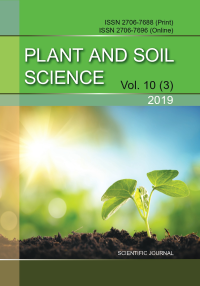Efficiency of preparation «Reakom» on chornozem ordinary on growing winter wheat
DOI:
https://doi.org/10.31548/agr2019.03.020Keywords:
soil, feed of plants, microelements, landscape, contamination, carbonates, ReakomAbstract
The article describes the importance of using micronutrients in the dry climate of the Southern Steppe of Ukraine on degraded soils under conditions of atmospheric pollution, violation of traditional schemes of crop rotation of crops and deficiency of organic fertilizers. The main purpose of the study, taking into account that the fertilization was carried out in a single scheme, both in terms of norms and technology, was to investigate the influence of soil ecological factors on the yield of winter wheat against the background of differentiation of the extracorporeal fertilization with the trace elements of Reakom (Zn, Cu, B, Mo, Co, P2O5, K2O) in a dose of 2.5 l/ha and 5 l/ha. The research was carried out on chernozem in the usual low-humus and its eroded abnormalities: weak and medium-sized, which marked the rise of carbonates due to some blurring of the upper accumulative genetic horizon and deterioration of qualitative soil fertility indices.
The yield of winter wheat on chernozem was almost 1.17% higher than that of 2.5 l/ha, compared to control, whereas there was no effect on the washed offs. For application of 5l/ha Reakom at discarded crop yields increased to 13.8% on medium-chernozem.
Effectiveness of the drug for foliar application of winter wheat in arid conditions on the abovementioned soil abnormalities is described by the regression equation, the use of which will allow the efficient allocation of funds when planning purchases of trace elements of trace elements.References
Alekseev YU.V. (1987). Tyazhyolye metally v pochvah i rasteniyah. [Heavy metals in soils and plants]. Agropromizdat, 142.
Glazovskaya M.A. (1988). Geohimiya prirodnyh i tekhnogennih landshaftov SSSR. [Geochemistry of natural and technogenic landscapes of the USSR]. Moscow: Vysshaya shkola, 328.
Il'in V.B. (1995). Sistema pokazatelej dlya ocenki zagryaznyonnosti pochvy tyazhyolymi metallami. [The system of indicators for the assessment of soil contamination by heavy metals]. Agrohimiya, 1, 94-99.
Sokolov M.S. (1995). Vozmozhnosti polucheniya ekologicheski bezopasnoj produkcii rastenievodstva v usloviyah zagryazneniya agrosfery (ekotoksikologicheskij aspekt). [Possibilities of obtaining ecologically safe crop production in conditions of pollution of the agrosphere (ecotoxicological aspect)], Agrohimiya, 6, 107-125.
Volod'ko I.K. (1983). Mikroelementy i ustojchivost' rastenij k neblagopriyatnym faktoram sredy [Microelements and plant resistance to unfavorable environmental factors].- Minsk: Nauka i tekhnika, 192.
ZHorobekova SH.ZH. (1987) Makroligandnye svojstva guminovyh kislot. [Macroligand properties of humic acids]. Frunze: Ilim, 196.
CHernysheva N.N., Svincova L.D., Gindullina T.M. (1995). Guminovye veshchestva prirodnyh vod – vozmozhnyj istochnik toksicheskih veshchestv pri vodopodgotovke. [Humic substances of natural waters - a possible source of toxic substances during water treatment]. Himiya i tekhnologiya vody,17/6, 601-608.
Anisimova M.A., Perminova I.V., Lebedeva G.F. (1998) Detoksiciruyushchaya sposobnost' guminovyh kislot po otnosheniyu k gerbicidu trifluralinu. [Detoxifying ability of humic acids in relation to herbicide trifluralin]. Pochvovedenie, 9,1079–1084.
Fateev A.I., Zaharova M.A. (2005). Osnovy primeneniya mikroudobrenij. [Bases of application of microfertilizers].Har'kov, 132.
Bondarenko V.I.(1977). Kornevaya sistema i produktivnost' ozimoj pshenicy. [Root system and productivity of winter wheat]. Kiev: Urozhaj, 73–88.
SHCHeglov D.I. (2003). CHernozyomy central'nyh oblastej Rossii: Sovremennoe sostoyanie i napravleniya evolyucii [Chernozems of the central regions of Russia: Modern state and directions of evolution]. Vestnik VGU. Seriya: Himiya. Biologiya. Farmaciya, 2, 187-195.
Afanas'eva Е.A. (1966). CHernozyomy srednerusskoj vozvyshennosti [Chernozems of the Middle Russian Highland]. Moscow, 224.
Rozov N.N., Samojlova Е.M., Polupan N.I. (1983). Russkij chernozyom: 100 let posle V.V. Dokuchaeva [Russian Chernozem: 100 years after V.V. Dokuchaev]. Moscow: Nauka, 309.
Fatєєv A.І., Pashchenko YA.V. (2003). Fonovij vmіst mіkroelementіv u gruntah Ukraїni [Background content of trace elements in soils of Ukraine]. Harkіv, 117.
Bulyhyn S.Yu., Demyshev L.F., Doronyn V. A., Zaryshnyak A.S., Pashchenko Ya.V., Turovskyy Yu.E., Fateev A.Y., Yakovenko M.M., Kordyn A.Y. (2007). Mykroэlementы v sel'skom khozyaystve [Trace elements in agriculture]. Dnepropetrovsk: Sych. 100.
Downloads
Published
Issue
Section
License
Relationship between right holders and users shall be governed by the terms of the license Creative Commons Attribution – non-commercial – Distribution On Same Conditions 4.0 international (CC BY-NC-SA 4.0):https://creativecommons.org/licenses/by-nc-sa/4.0/deed.uk
Authors who publish with this journal agree to the following terms:
- Authors retain copyright and grant the journal right of first publication with the work simultaneously licensed under a Creative Commons Attribution License that allows others to share the work with an acknowledgement of the work's authorship and initial publication in this journal.
- Authors are able to enter into separate, additional contractual arrangements for the non-exclusive distribution of the journal's published version of the work (e.g., post it to an institutional repository or publish it in a book), with an acknowledgement of its initial publication in this journal.
- Authors are permitted and encouraged to post their work online (e.g., in institutional repositories or on their website) prior to and during the submission process, as it can lead to productive exchanges, as well as earlier and greater citation of published work (See The Effect of Open Access).

